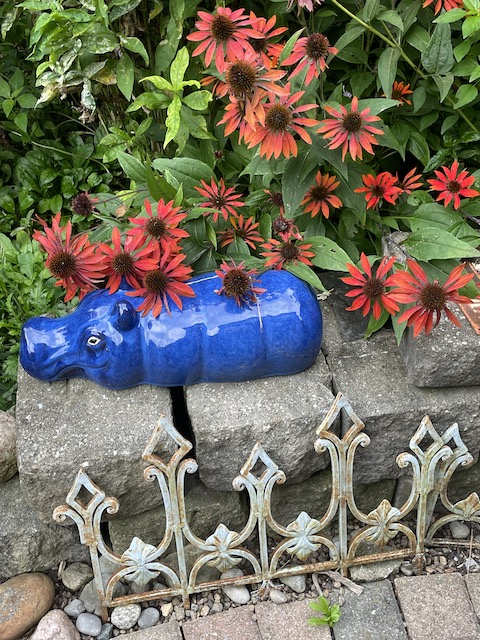| Back to Back Issues Page |
 |
|
Garden Bliss & Blunder, Issue #037 June 07, 2024 |
June is Perfection...“I wonder what it would be like to live in a world where it was always June.” Lucy Maud Montgomery (1874-1942)
June's Magic Begins....
What a gift ! from my friend's garden... she is gone but not forgotten, and her lovely plant lives on in my garden, ever reminding me of her friendship.
Variegated Iris and a rescued bunny with one ear.
Take Time to Smell the Roses.......even if they aren’t in your garden - appreciate someone else’s
“When I am alone I can become invisible. I can sit on the top of a dune as motionless as an uprise of weeds, until the foxes run by unconcerned. I can almost hear the unbearable sound of the roses singing.” Mary Oliver ...do peonies sing?
Colour in our Gardens...There are many ways to use colour.... flowers, plant leaves, or fun things. It helps to thread colour throughout your garden so your eye will start in one place and then lead to another... and another .. like the colour burgundy here...see how the front deep burgundy Heuchera leads your eye to the burgundy of the Redbud leaves?
...or use leaves and texture to do this too with different types of Fern, Hosta, Rogersia (burgundy leaves in centre) and Heuchera
... or how about peach or marmalade? ... a switch from pinks or reds especially in part shade gardens.. See how your eye moves from one spot of colour through the garden to the next.... It punches up the green
Lovely Lady Bugs...
Photo credit: Hasan Jasim
Did you know a large group of Lady Bugs is called a Loveliness of Lady Bugs? I love that...
But not all cute spotted bugs are Lady bugs...
Illustration: Better Homes & Gardens What about Ants?
REALLY? Yes and here is the neat stuff about it.... Myrmecochory is the dispersal of seeds by ants. Most myrmecochorous plants produce seeds with elaiosomes or "food bodies", or structures attached to the seed, rich in lipids, amino acids or other nutrients: very attractive to ants. The seed with its attached elaiosome (food bodies) is collectively known as a diaspore. Ants disperse seeds when foraging workers carry diaspores back to the nest, after which the food bodies (elaiosome) are removed or fed directly to ant larvae. Once this is consumed, the seed is usually discarded in underground middens (refuse heaps) or ejected from the nest. Although diaspores are seldom distributed far from the parent plant, the plant benefits - because not all seeds will fall onto ground close to the plant - which would just attract more insects - (like a bird feeder). from AntWiki: The Ants Boulevards...Usually mostly unused except for garbage pickup and recycling... But try this... just be sure whatever you plant does not inhibit visibility for cars and folks. Also, if you live where winters are full of snow and ice, cover the plants with piles of leaves to keep road salt and sand from damaging plants... they need to resilient and grown near you. These roses are very low maintenance... bloom all summer and get watered when it rains. Grown in Canada, they are hardy and oh, so easy. The apple trees are dwarf and kept pruned - and yes, produce apples !! (It's early June, so they are just in bud.... more photos when they bloom in a few weeks)
Gas Plant...Gas Plant - Dictamnus albus
WARNING: Another common name for the gas plant is burning bush because of the highly flammable oil it produces. This oil can volatilize and create a gas around the plant on hot, windless days. When lit with a match or lighter, this gas goes up in quick flames, enveloping the plant in a burst of fire, but not consuming it. In most cases, the oil burns off too quickly to damage the plant, but surrounding plants could be harmed—particularly in dry conditions. ANOTHER WARNING: contact with this plant can cause phytophotodermatitis (phyto, which means plant photo, which means sunlight dermatitis, which is inflammation of the skin in some people— It's a condition said to mimic the look and discomfort of poison ivy. It’s best to wear gloves, arm coverings, and other protective gear when working near or handling this perennial especially if there is a chance you can break a stem and have the oil touch your skin. Still worth the effort and care though and the pink is particularly lovely. Watering...POTS and CONTAINERS:
Water every day and use an organic liquid feed once a week Plastic pots heat up and dry the soil quickly so they will need more water than plants in clay or fibrous pots Deadheading spent flowers prevents them going to seed, encouraging more blooms Cut back when blooms are done = it tidies and lets other plants to bloom In extreme heat, move the pots (if possible) to a more sheltered place for a day or two. Watering New Plants...Before you buy: READ THE TAG carefully…. yes, push the zone, but remember most tags are printed in the US and use USA zones. Our Canadian zones can be a zone lower (USA zone 5 is often our zone 4) - If you push the zone, do it intentionally and know your precious plant might not have the strength to overwinter. The link below will help determining your zone. As for PERENNIALS, - we plant them because we want our gardens to be “maintenance free” (that actually never happens) - so all new plants need attention (water and a bit of fussing) for the first few weeks. They need a chance to adjust from being wrenched (yes, we do) out of their tidy, tight and comforting pots into 'foreign' soil. Fill the planting hole with water and let it drain to half…. place the new plant in and cover roots to the base with the same soil as in your garden … DON'T add new soil…. put compost on TOP of the soil and water in well. Feed the soil… not your perennials.
Ready for a Hot Summer?Water your garden well - early in the morning, or early evening. Add compost when the soil is moist and cool, then add mulch before the soil dries out. Mulch keeps soil moist and nutrient rich Keep Bird Baths clean and small dishes with stones for bees and chippies ...
Weeds...
Has your garden got out of control? Lots of work, but worth the time and effort. . if you have both….then start with the weeds

...then edge and mulch  But what if you don't have time or energy?
But what if you don't have time or energy?
Then start by edging.... and weed into the garden 8 to 10 inches all around the outside and then mulch.... You will have 2 things: 1. a defined garden bed 2. a place to step to begin on the inside The mulch will keep the weeds down and the soil nourished and moist in the meantime it looks cared for. Another trick? Plants close together will also keep weeds down while shading the roots.
Weeding Paths...
A thick layer of wood chips makes a great path between beds. But what if your path is small stones ?
... EASY !
DONE !! Add Fun to your Garden...
A great way to add interest, fun, or even a diversion from a view that doesn't fit your garden vision.
Meet "Henrietta" Hippo and "George" the Dragon
Most of all, have fun. ... and if goofy things (or beautiful) make you smile? then go for it.
Just be sure to enjoy it all Until Next Time...
When you find life overwhelming - go to the garden…
Lucy says....
... If you need a snack, pop over to your neighbour’s - but be sure to wait to be invited in.
.. or follow her home because you know she has a bag of treats.
Please take a look at the rest of my site .... here a few links you might go to first. planting-roses.html planting-trees.html black-walnut-tolerant-plants.html Back Issues for Garden Bliss & Blunder
|
| Back to Back Issues Page |






























